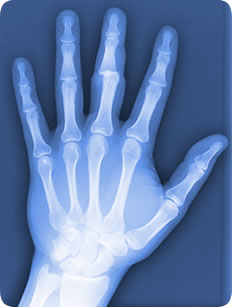Dislocated Finger
Symptoms
Dislocated finger is a common injury, it often occurs as the result of catching the finger awkwardly and in sports. The joint most often dislocated is the first joint in the finger, the PIP joint.

Diagnosis
The diagnosis of a finger fracture and decision of how to treat it is usually made with good quality X rays in addition to a thorough examination of the finger. In some cases a scan is required.
Treatment
 A dislocated finger joint first needs to be put back into position. Sometimes this is done 'on the field' by someone with medical
experience, or in an A&E department. Further treatment by a specialist is always required to ensure a rapid recovery, to prevent
further injury occurring while the finger is healing and to help regain full range of movement.
A dislocated finger joint first needs to be put back into position. Sometimes this is done 'on the field' by someone with medical
experience, or in an A&E department. Further treatment by a specialist is always required to ensure a rapid recovery, to prevent
further injury occurring while the finger is healing and to help regain full range of movement.
After examining the finger, particularly to assess the ligaments around the joint and the joint surface, an X-ray is taken. An X-ray shows if there is an associated fracture, not an uncommon situation. When a joint is dislocated, the ligaments around the joint are damaged – either partly or completely torn. Treatment is directed to getting the ligaments healed and restoring a stable joint with full range of movement.
Once the dislocated joint is back in place, the stability of the joint is assessed. If the joint is relatively stable, a splint will be used to protect the joint an prevent dislocation recurring while the finger is healing. Splintage may use a neighbouring finger to strap the injured one to (buddy strapping), or a more definitive custom made plastic splint that provides a greated amount of protection. In cases where the joint is unstable after reduction, it may be necessary to hold the joint in the correct position using a fine, stiff wire (K-wire) drilled across the joint. This is a minor operation. Hand therapy (specialised physiotherapy). It is very important following a dislocated finger, to prevent the joint from becoming stiff (this can occur quite quickly). Hand therapy involves a tailored programme of exercises, physical therapy such as stretching, and sometimes other treatments, for example ultrasound. You will also have exercises to do at home.


